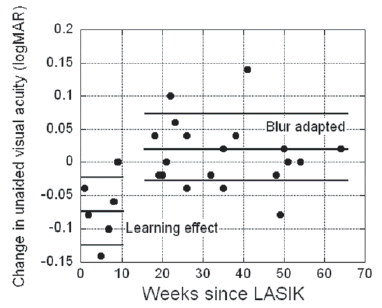Involvement of Neural Adaptation in the Recovery of Vision After Laser Refractive Surgery
PURPOSE: To investigate whether the gradual improvement in unaided visual acuity commonly seen after laser refractive surgery is attributable, in part, to neural adaptation to blur.
METHODS: Unaided logMAR visual acuity was measured at presentation (blur adapted) and immediately after refraction and removal of refractive correction (correction adapted) in 26 patients with low myopic residual refractive error after laser in situ keratomileusis (LASIK). The difference in unaided visual acuity (correction adapted - blur adapted) indicates a dominance of practice effect (if negative) or blur adaptation (if positive). A combination of blur adaptation and practice effect is possible.
RESULTS: Overall, the mean unaided visual acuity at presentation (blur adapted) was 0.16±0.16 (meanąstandard deviation) logMAR, and the mean unaided visual acuity immediately after refraction and removal of refractive correction (correction adapted) was 0.14±0.14 logMAR, giving a difference (correction adapted - blur adapted) of -0.02±0.06 logMAR. This difference was not significant (analysis of variance [ANOVA] F1,25=0.204, P>.05), suggesting neither blur adaptation nor practice effect. However, during the first 10 weeks after surgery, the difference in unaided visual acuity was -0.07±0.05 logMAR, suggesting a practice effect. After 10 weeks, the mean difference was +0.02±0.05 logMAR, suggesting any practice effect is offset by blur adaptation. These values were significantly different (ANOVA F1,25=13.53, P<.01).

Figure. Blur adaptation represented by the difference in unaided visual acuity (adapted to refractive correction - adapted to blur) as a function of weeks since surgery. In the first 10 weeks (n=7), the mean difference is -0.07±0.05 logMAR, suggesting no blur adaptation but a practice effect where vision is better on the second testing. After 10 weeks (n=19), the mean difference is +0.02±0.05 logMAR, demonstrating the practice effect is offset by blur adaptation. The means of these two groups were significantly different (ANOVA F1,25=13.53, P<.01).
CONCLUSIONS: These data suggest that patients do not adapt to surgically induced blur, on average, until 10 weeks after LASIK. The reason for this delay is uncertain; perhaps instability of blur hinders adaptation during the early postoperative period. Part of the gradual visual improvement after LASIK appears to be due to neural adaptation to blur.
Journal of Refractive Surgery 2005;21:144-147
Received: March 19, 2004
Accepted: August 30, 2004
Konrad Pesudovs PhD
From the Department of Ophthalmology, Flinders University and Flinders
Medical Centre, Bedford Park, Australia.
![]() Blur Adaptation as PDF (89 Kb)
Blur Adaptation as PDF (89 Kb)
![]()
Index of Papers
[
Welcome ][ Publications ]